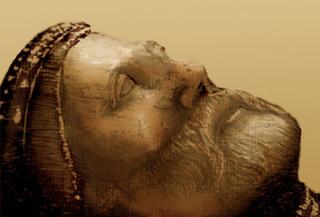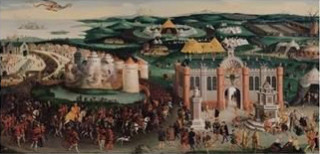St Mary's Bottesford Phase V.I, Monument to Thomas Manners, 1st Earl of Rutland
By Bob Sparham
Thomas, 1st Earl of Rutland 1543
Edmund, Lord Roos had died childless and his niece and heiress, Eleanor, married Sir Robert Manners thus creating the present Manners family name.Sir Robert’s son, Thomas was created the first Earl of Rutland in 1526 by King Henry VIII. The Roos and Manners family had been high in the favour of the Tudors since Bosworth and Thomas was rewarded by the Earldom and by membership of the Order of the Garter in 1525. In the very next year Henry began the process that would transform St. Mary’s and every other church in the kingdom as well as the lives of ordinary people. The king wanted to divorce his wife, Katharine of Aragon, mostly because he desperately needed a male heir, but also because he was romantically attracted to Anne Boleyn. The complicating factors were the reforms of religion which were taking place in Europe. Martin Luther believed that the church had lost its way and was both wicked and corrupt. As they read their newly printed bibles, Protestants, believed that the church was ignoring one of God’s commandments – that thou shalt not worship graven images.
Unable to reach an agreement with the Pope, Henry renounced the Catholic religion in 1534 and began a series of Protestant religious reforms which included the destruction of monasteries. After displaying some initial sympathy toward Katherine of Aragon, Thomas, Earl of Rutland was a close supporter of Henry’s actions. He helped Henry with the divorce and was one of the generals who suppressed the Catholic monastic rebellion of 1536 in Yorkshire and Lincolnshire which is known as the Pilgrimage of Grace. Some of the facts taken from his entry in the Dictionary of National Biography are:-
“On 22 June 1513 Thomas landed at Calais on the French expedition. The same year he became Baron Roos on his father’s death, and was summoned in 1515 to parliament. He was at the Field of the Cloth of Gold in 1520 and at Henry VIII’s meeting with Charles V afterwards. In December 1521 he became cupbearer to the King; in January 1522 he was made steward of Pickering, Yorkshire; and from April to October of the same year he held the appointment of lord warden of the east marches, in which he was succeeded by Lord Percy. He was appointed Knight of the Garter on 24th April 1525, and 18th June 1525 he was made Earl of Rutland. He was a great favourite of Henry VIII and had many grants. On 11th Oct 1532 he landed with Henry in France; he was at the coronation of Anne Boleyn in 1533, and he took part in her trial. When Anne of Cleeves came to England Rutland was appointed her lord chamberlain, and met her at Shooter’s Hill after her unfortunate interview with the King at Rochester”p941.
Henry VIII gained large amounts of land and property from the dissolution of the monasteries, most of which were sold off cheaply to finance his attempt to reconquer France. Thomas was granted both Belvoir Priory and Croxton Abbey (as well as many other monastic properties and lands), and he ensured that many of the monuments to his family were removed from what became their ruins to St Mary’s. He began the reshaping of the chancel and is buried before the altar in what was a traditional chest tomb next to his wife and surround by weepers who pray to speed their souls through purgatory.











No Comments
Add a comment about this page